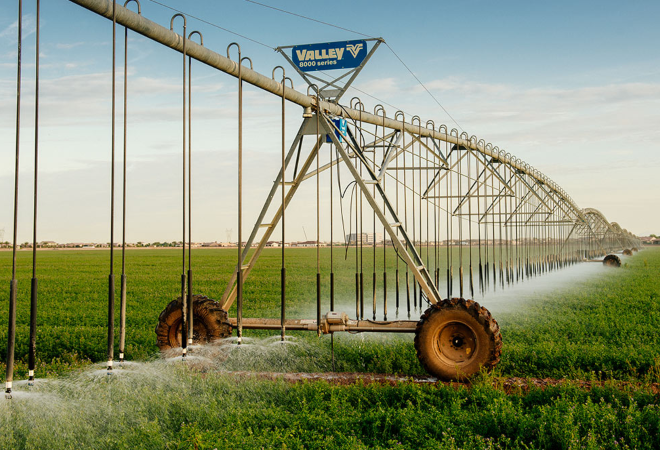
Tech advancements turning trusty center pivot into multi-pronged precision agriculture tool
New technology is transforming the center pivot beyond a tried and trusted irrigating tool to one that can measure its own efficiency, as well monitor fields for weed or pest problems.
Some of that new irrigation tech was presented during a pair of virtual sessions during Potato Expo 2021.
Valley Insights
Valley Irrigation partnered with data collection and analyzation firm Prospera Technologies to create Valley Insights, a platform that takes imagery collected by on-pivot cameras and sensors and then utilizes artificial intelligence (AI) to provide analysis for growers and agronomists.
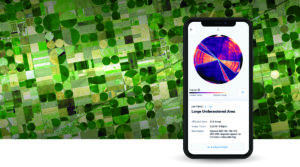
Pivots are equipped with up to 10 high-resolution, weather-proof sensors that can capture field conditions as they irrigate, day or night.
“Night vision is a big deal,” said Darren Siekman, Valley’s vice president of water delivery and business management. “In a lot of arid environments, we do have irrigation that goes on at night.”
The AI learning portion of the platform will eventually be able to detect specific weeds or plant conditions and then provide that information in simple form, rather than the user having to go through vast amounts of images or data to reach their conclusion. Building up the AI algorithms is currently ongoing.
“We’re really just scratching the surface,” he said of the platform’s capabilities.
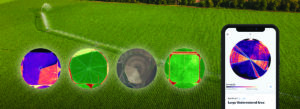 The sensors are GPS-equipped, which allows growers to quickly pinpoint and follow up in troublesome areas. They’re electrically powered through the pivot, but an internet connection is needed to send notifications and updates to the user’s smartphone app. Information, whether all or partial, can be easily shared with others.
The sensors are GPS-equipped, which allows growers to quickly pinpoint and follow up in troublesome areas. They’re electrically powered through the pivot, but an internet connection is needed to send notifications and updates to the user’s smartphone app. Information, whether all or partial, can be easily shared with others.
Ease of use and cutting down on data analysis were front of mind in development.
“We can overwhelm ourselves with massive amounts of information and the coolness of (new technology), but at the end of the day, I just want to know what’s going on in my field and what should I do about it,” Siekman said.
Trevor Mecham, Valley’s VP of global technology, grew up scouting potatoes and driving roads. He said what excited him the most is being able to cover ground faster and getting information in a way that will allow growers to act quickly. Being able to pinpoint stressed plants or problem areas faster and more accurately will improve yields and cut down on input costs.
“To be able to cover more ground and get to a predictive state rather than a reactive state is going to be crucial in the coming years as we have to produce more produce with less,” Mecham said.
Smart Pivot
In November, Lindsay Corp. announced the Smart Pivot, which combines the FieldNet agronomic imagery system, the Zimmatic machine health system and the Taranis precision scouting system.
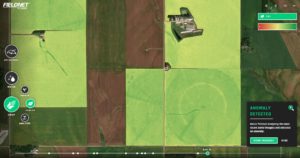
Wade Sikkink, Lindsay’s director of product management, used the evolution of the telephone to the smartphone as a comparison of what the Smart Pivot can do versus a traditional center pivot.
“There were improvements to the phone over the course of time, but there were always just improvements to the one key function the phone had: talking to people,” Sikkink said during Potato Expo. “What made the smartphone possible were advancements in computer power and bandwidth.”
The utilization of Edge computing brings the necessary computing and bandwidth advancements to make the Smart Pivot possible.
Rather than sending the data to the cloud to make sense of it, with Edge computing, we can do everything we need to do with the data in-field,” said Kurtis Charling, Lindsay director of software development. “This significantly improves response time, saves bandwidth and allows for more processing, insights and decisions to be made at the pivot.”
The pivot has a series of sensors that monitor fields as it moves, which can allow it, through AI learning, to detect pests, diseased plants, ponding water or other issues, report them back to the user, make a recommendation and then allow the user to approve or decline the recommendation. If approved, the pivot can instigate the action, whether it be to apply pesticide, alter irrigation levels or deploy a drone to collect more information.
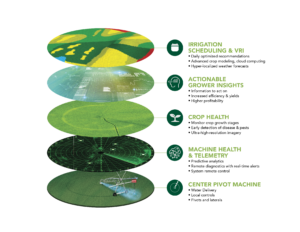 “Insights are good, but without the ability to act on those insights and improve performance of your operation, they aren’t very valuable,” Sikkink said.
“Insights are good, but without the ability to act on those insights and improve performance of your operation, they aren’t very valuable,” Sikkink said.
The pivot monitors the field, but also monitors itself with the machine health technology. This allows it to preemptively report a problem. For example, a tire showing decreasing pressure.
Grower Mike Pink of Mesa, Washington, has been using FieldNet on his pivots for five years and said it’s the most valuable tool at his disposal. He expressed excitement at the possibilities of the Smart Pivot.
“It’s great to be able to see a problem, but the ability to see a potential problem is even better,” Pink said. “That allows me to get the pivot to the pivot road, stop it there and already have it pretty well diagnosed.
“My people can have the parts on the truck when they get it.”
In addition, Lindsay is working on what Sikkink called “ultra-high speed technology” for pivots.
“This technology that is in development will allow a standard quarter-mile pivot to make a circle in two hours or less,” he said.
Top photo: Valley Irrigation







